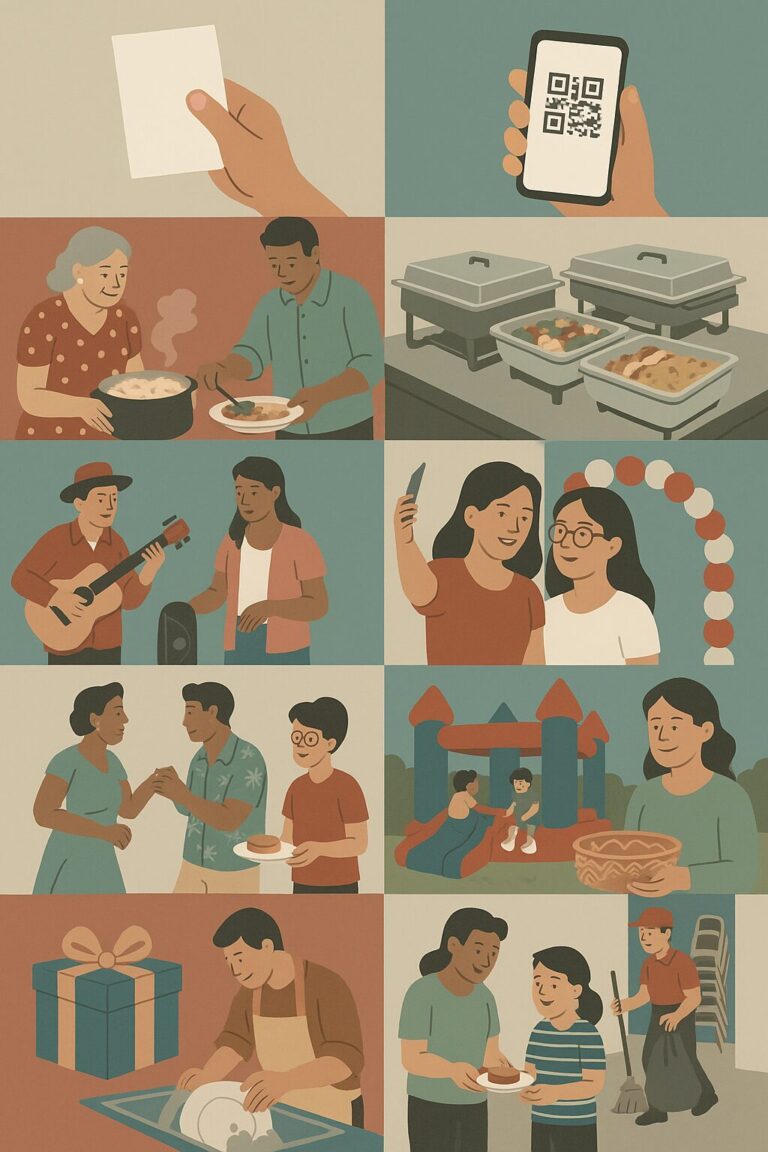Parties used to be simple. Someone’s aunt cooked too much, a neighbor dragged over extra chairs, and an uncle who sang off-key became the headliner by default. The modern fiesta is a different creature. It photographs beautifully, it travels through group chats in seconds, and it often runs on logistics software more than tradition. Some of that change is welcome. Some of it has quietly shaved off pieces of what made gatherings feel human.
Below are seven shifts I keep noticing, what each one has given us, and the bit of soul that went missing on the way.
From open door to guest list
Neighborhood fiestas used to operate on the “if you can hear the music, you are invited” rule. Today’s parties often look like small events, complete with RSVPs, QR codes, and a headcount tracked in a spreadsheet.
What we gained
Clarity, fewer awkward surprises, better budgeting. Hosts waste less food and can match seating to bodies.
What we lost
Serendipity. The cousin who brings a friend who turns out to be a brilliant dancer. The neighbor you barely know who becomes part of family lore because he showed up with a trumpet.
Invitations then vs now
| Aspect | Then | Now | Hidden cost |
| How people were invited | Word of mouth, paper notes | E-vites, DMs, QR codes | Fewer happy accidents |
| Who decides the list | Whoever heard about it | Host plus spreadsheet | Higher social anxiety |
| Food planning | Cook a lot, send leftovers | Precise portions | Less room for strays |
A small fix
Leave one corner of the party open. Tell three guests they can bring a plus-one without checking first. The best stories still arrive unannounced.
From potluck tables to curated menus
A potluck used to be a democratic buffet. Aunties competed playfully over spice levels, and someone always smuggled in a family secret. Many modern fiestas outsource food to a caterer or a delivery app. The result looks uniform, which can be lovely on camera.
What we gained
Consistency, dietary labels, less kitchen stress for hosts. People with allergies breathe easier when a tray says what it is.
What we lost
Regional quirks and family signatures. The chile that tastes like your grandmother’s hands. The stew that only appears when your brother cooks because he cheats with three kinds of onions.
Research in plain language
Food memories bind groups. Studies on “sensory-evoked nostalgia” show that smell and taste anchor social identity better than photos. When menus become generic, that anchor loosens.
A small fix
Keep one “family shelf.” Even with a caterer, reserve a table for three homemade dishes and handwritten labels that say who made them.
From live music to playlists
The neighborhood guitarist got replaced by a Bluetooth speaker. Playlists are reliable. Live music is not. Reliability feels safer on a busy night.
What we gained
No awkward applause gaps. No broken strings or off-key moments. Everyone can submit songs in advance.
What we lost
A communal pulse. Live rhythm can coax shy people onto a dance floor. Imperfections make participation easier because nobody has to compete with studio polish.
Music’s social function
| Feature | Playlist | Live player | Social effect |
| Precision | High | Low to medium | Playlists control mood tightly |
| Participation | Passive | Active | Live music invites call-and-response |
| Memory trace | Song-centric | Moment-centric | Live mistakes become jokes and stories |
A small fix
Keep the playlist. Add a 20 minute live slot. One friend with a cajón, another with a guitar. Nobody needs to be professional. The point is to turn guests into makers, not only listeners.
From stay-put to content-ready
Parties used to happen in one place until they ended. Modern fiestas often include a “content zone.” Neons. Balloon arches. A photo wall. Everyone rotates through for three seconds of proof.
What we gained
Great photos. Clear memories. Distant friends get a window into our lives.
What we lost
Flow. Movement becomes performative rather than organic. People spend more time capturing the party than being at the party. Several studies show that filming an event slightly weakens memory for the experience itself because attention splits.
A small fix
Choose a single capture ritual. For example, a group photo at midnight. After that, declare the party a camera-light zone, except for candid quick snaps. You will feel conversation deepen by the next song.
From all-ages chaos to kid zones
Children used to weave through legs, fall asleep on chairs, and occasionally spill juice on someone famous in the family. Kid zones changed that. Helpful, yes. Also isolating.
What we gained
Safety, breathing room for adults, activities that match attention spans.
What we lost
Apprenticeship in how to be around grown-ups. Kids learn party etiquette by proximity. They see how an argument softens into laughter. They watch their parents apologize. When children are outsourced to an inflatable castle, they miss the soft skill curriculum.
What kids learn at a mixed-age fiesta
| Lesson | How it appears | Future payoff |
| Turn-taking in conversation | Two uncles trading stories | Better classroom behavior |
| Repair after conflict | Aunties making up over coffee | Stronger friendships |
| Helping as belonging | Passing plates, stacking chairs | Community instinct |
A small fix
Bring kids back for one ritual. Teach a simple clapping pattern or a call-and-response song. Let them serve dessert with you. They will remember being useful.
From gifts to experiences, then back again
There was a time when a blender on the gift table felt normal. Minimalism pushed back. People asked for “no gifts, experiences only,” then discovered that experiences also carry logistics and cost. We now live in a hybrid that can confuse everyone.
What we gained
Less stuff, more shared moments. Digital gift cards make long-distance kindness easy.
What we lost
The tactile reminder that someone thought of you. A handwritten note tucked into a book. A serving bowl that travels from party to party for a decade.
A small fix
Set a theme that links memory to use. “One object you already love in your kitchen that you are ready to pass to another home.” Stories arrive with the items. Clutter does not.
From communal cleanup to professional teardown
The most honest part of a fiesta used to happen after the last song. People carried bags to the trash, argued gently over leftovers, and hunted for missing Tupperware lids. Clean-up is now often handled by staff, which feels like relief when your feet hurt.
What we gained
Speed, hygiene, and mercy for tired hosts.
What we lost
The bonding that happens when work ends together. Anthropologists talk about “communitas,” the sense of equal footing born of shared effort. A broom in a friend’s hand is not romantic, but it turns acquaintances into co-owners of the night.
The psychology of the final twenty minutes
| Action | Old norm | New norm | Social effect |
| Leftovers | Divided on the spot | Packed by staff | Fewer post-party touchpoints |
| Dishes | Group rinse line | Commercial tubs | Less casual conversation |
| Goodbye | Lingers during cleanup | Quick hugs at the exit | Thinner closure |
A small fix
Keep one job unoutsourced. Ask three people to stay ten minutes to wrap leftovers for neighbors. It will feel like a tiny village formed and dissolved at your sink.
Why these shifts happened
The forces are obvious once you say them aloud. Urban life made neighbors strangers. Apps turned coordination into a dashboard. Housing shrank, so kitchens outsourced meals to restaurants. Phones created a parallel event that runs above the actual one. Safety norms tightened, which helped in many ways, but sometimes swapped trust for proof. None of this is evil. It just needs rebalancing.
A pinch of research, kept human
- Studies on “weak ties” suggest that chance encounters at community events boost well-being and even job opportunities. Invitation walls reduce those ties.
- Experiments on shared labor show that cooperative chores increase feelings of closeness more than shared entertainment alone. Cleaning up together really does matter.
- Memory science keeps finding that participation beats observation. When guests contribute a dish, a song, or a task, they remember the night more vividly.
A short field guide to hosting with soul in 2025
Below are small, concrete moves that restore warmth without giving up modern conveniences.
- Run a two-tier invitation. Core list by RSVP, plus an open hour near the end for friends-of-friends.
- Keep a “heritage bite.” Commission the caterer for most of it, then ask three relatives for one dish each. Put their names on the cards.
- Schedule one live moment. A toast, a song, a dance lesson, a poem. Ten minutes, low pressure, high memory.
- Designate a memory officer. One person captures three photos and a 10-second video. That is enough.
- Mix ages on purpose. A short shared ritual pulls kids and elders into the same frame.
- Tell a gift story. If you invite gifts, set a simple rule that adds meaning. If you do not, suggest one donation everyone can make together.
- End with a circle task. Before staff arrive, ask five people to help you send leftovers to neighbors or pack take-home trays. Conversation during this window is always better.
What we are trying to keep
Under the playlists, balloon arches, and QR codes, a fiesta is still a promise. We feed each other to remember who we are. We sing or laugh to say that ordinary life has a border and tonight we stepped over it. All the modern extras can serve that purpose if we keep them in proportion. The trick is simple. Design the party so at least one part cannot happen without the people who show up.
I still love the polished photos on the morning after. I also love the stain on the tablecloth that will not quite come out because someone got carried away with a ladle. Both are evidence that a group shared a night. If the modern fiesta can hold room for polish and stain, we have not lost anything that matters. We have just learned how to carry it into a faster world.


